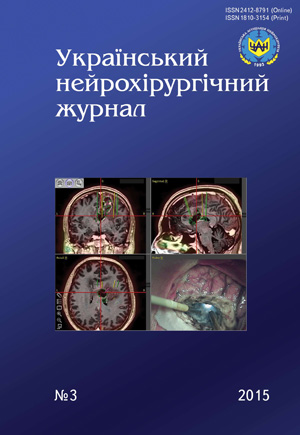The effectiveness of the method of stabilizing segment C1-C2 Harms in fractures of the odontoid process of C2 vertebra type II
DOI:
https://doi.org/10.25305/unj.50113Keywords:
dens C2 fracture, surgical stabilizationAbstract
Objective. To determine the effectiveness of C2 dens fracture stabilization using Harms method, and to assess the quality of life of patients in the early and late postoperative period.
Materials and methods. Analyzed 11 cases of C2 dens fractures type II, which were operated in the Department of Neurosurgery Vinnytsia Regional Psychoneurological Hospital for the period 2012-2014. All operation were made using Harms method.
Results. Efficacy was estimated via using the VAS score and the NDI before, 1 and 6 months after surgery. Moreover we performed CT before, 1-2 day after, and 6 month after the operation.
Before surgery NDI in average was 46%, first days after the operation median - 28%. One month later, the median value of NDI is 19%. After 6 months and future NDI is not greatly changed (average 15%).
VAS before operation was 6.2. First days after operation median score was 6. This score was being reduced to 2.2 after one month and progressively to 0.33 after 6 months.
CT performing first days after operation were needed to confirm right positioning of screws. 6 months after the operation CT were been done to all patients. It showed good bone healing in fracture line.
Conclusions. Harms method of C1-C2 stabilization is an effective method for surgical treatment of C2 II type fracture. Over 6 months after operation patients returns to their usual activity without pain.
References
1. Scheyerer MJ, Zimmermann SM, Simmen H-P, Wanner GA, Werner CM. Treatment modality in type II odontoid fractures defines the outcome in elderly patients. BMC Surgery. 2013;9:13-54. [CrossRef] [PubMed]
2. Midov MZ, Dreval’ ON, Dzukaev DN, Kuznetsov AV, Zavarukhin VB. [Diagnosis and treatment of complicated subaxial injury]. Zh Vopr Neirokhir Im NN Burdenko. 2010;3:48-54. Russian. [PubMed]
3. Polishchuk NE, Korzh NA, Fishchenko VYa, Slyn’ko EI., editors. Povrezhdeniya pozvonochnika i spinnogo mozga (mekhanizmy, klinika, diagnostika, lecheniye) [Spine and spinal cord injuries (mechanisms, clinical features, diagnosticis, treatment)]. Kiev: Kniga-plyus; 2001. Russian.
4. Hasler RM, Exadaktylos AK, Bouamra O, Benneker LM, Benneker LM, Clancy M, Sieber R, Zimmermann H, Lecky F. Epidemiology and Predictors of Spinal Injury in Adult and Major Trauma Patients: European Cohort Study. Eur. Spine J. — 2011;20(12):2174-2180. [CrossRef] [PubMed]
5. Lin VD, editor. Spinal Cord Medicine: Principles and Practice. New York: Demos; 2003. p.107-153.
6. Takhar M. [Capabilities of radiodiagnosis of cervical spine injuries]. International Medical Journal. 2009;15(2):133-136. Russian.[Publisher Full Text]
7. Abdullaev RYa, Takhar M, Spuziak MI, Kolomiychenko YuA, Grigoruk MA. [Duplex scanning at atlas subluxation in children]. International Medical Journal. 2011;17(2):95-97. Russian.[Publisher Full Text]
8. Scalici E, Indorato F, Portelli F, Savi T, Maresi E, Busardo FP. A fatal iatrogenic right vertebral injury after transoral odontoidectomy and posterior cervical stabilization for a type II odontoid fracture. J. Forensic. Leg. Med. 2014;22:41-44. [CrossRef] [PubMed]
9. Lau D, Shin SS, Patel R, Park P. Treatment of C2 body fracture with unusual distractive and rotational components resulting in gross instability. World. J. Orthop. 2013;18(4):323-326. [CrossRef] [PubMed]
10. Meshcheryakov IV. [Clinical manifestations of non-consolidated fracture of the C2 dens (without dislocation)]. The Manual Therapy Journal. 2013;[2]:41-47. Russian.
11. Skoromets AA, Skoromets AP, Skoromets TA, Tissen TP. Spinalnaya angionevrologiya: rukovodstvo dlya vrachey [Spinal Angiology: Guidelines for Physicians]. Moscow: MEDpress-inform; 2003. Russian.
12. Carroll E, Gordon B, Sweeney C, Joy S, Connolly P. Traumatic Atlantoaxial Distraction Injury. Spine. 2001;26(4):454-457. [CrossRef] [PubMed]
13. Dickman C, Sonntag V. Posterior C1-C2 Transarticular Screw Fixation for Atlantoaxial Arthrodesis. Neurosurgery. 1998;43(2):275-281. [CrossRef] [PubMed]
14. Aebi M, Etter C, Coscia M. Fractures of the odontoid process: treatment with anterior screw fixation. Spine. 1989;14(10):1065-1070. [CrossRef] [PubMed]
15. Bazhanov SP, Gulyaev DA, Norkin IA, Ostrovsky VV, Primak NA, inventors; FSBI Saratov Institute of Orthopedics and Traumatology, Saratov, Russian Federation, assignee. Method of spondylolisthesis at traumatic injuries of upper cervical spine. Russia. Patent 2511485A. 2014 April 10.
16. Harms J, Melcher R. Posterior C1-C2 fusion with polyaxial screw and rod fixation. Spine. 2001;26(22):2467-2471. [CrossRef] [PubMed]
17. Steltzlen C, Lazennec JY, Catonne Y, Rousseau MA. Unstable odontoid fracture: surgical strategy in a 22-case series, and literature review. Orthop Traumatol Surg Res. 2013;99(5):615-623. [CrossRef] [PubMed]
18. Lohrer L, Raschke MJ, Thiesen D, Hartensuer R, Surke C, Ochman S, Vordemvenne T. Current concepts in the treatment of Anderson Type II odontoid fractures in the elderly in Germany, Austria and Switzerland. Injury. 2011;43(4):462-469. [CrossRef] [PubMed]
Downloads
Published
How to Cite
Issue
Section
License
Copyright (c) 2015 Valeriy Olkhov, Kostyantyn Gorbatyuk, Oleksandr Lemeshov

This work is licensed under a Creative Commons Attribution 4.0 International License.
Ukrainian Neurosurgical Journal abides by the CREATIVE COMMONS copyright rights and permissions for open access journals.
Authors, who are published in this Journal, agree to the following conditions:
1. The authors reserve the right to authorship of the work and pass the first publication right of this work to the Journal under the terms of Creative Commons Attribution License, which allows others to freely distribute the published research with the obligatory reference to the authors of the original work and the first publication of the work in this Journal.
2. The authors have the right to conclude separate supplement agreements that relate to non-exclusive work distribution in the form of which it has been published by the Journal (for example, to upload the work to the online storage of the Journal or publish it as part of a monograph), provided that the reference to the first publication of the work in this Journal is included.









